The First Piano to Arrive in NSW Chapter 4 – Rondo
The Longman & Broderip piano in the laundry
I have a different proposal for provenance for the George Worgan piano. In 2007, Bill Bradshaw signed a document1 outlining the history of the Longman & Broderip piano as he knew it. Around the same time, Bradshaw also signed a statement about the provenance of the Longman & Broderip piano.2 Whilst Bill might add a bit of “puff” to his sales pitch, he certainly would not sign a document that was perjurious. I spoke about this to the Honourable Paul Keating, former Prime Minister of Australia. He and Bill Bradshaw were good friends. Mr Keating said to me, “Bill Bradshaw might gild the lily a little, but not on something like this. A musical instrument was important to him. In the end, it comes down to Bill Bradshaw’s professional pride – he would not misrepresent something. If Bill Bradshaw had already sold a piano with such provenance, he would NEVER sell another with the same provenance”3. Bill Bradshaw, in his written statement, said he had originally bought the piano in 1942 from a family called Mathews (or Matthews), who lived near Parramatta. It was a wreck when he bought it – it was in the laundry – not fit to be in the house, the keys were missing, thought to have been burnt in the chip heater, it had a rat’s nest in it and it was full of borers. The family had only kept it as they had it in family tradition that it was Mrs Macarthur’s piano and it had been in the family for two or three generations. Bill was 20 at the time he bought the piano but had already been operating as an antiques dealer for four years with his mother Ruby, who had the antique dealer’s licence. The Longman & Broderip piano was sold to Albert Briskie, a piano dealer, and later, in about May 1969, Bill bought the piano back from that dealer, and sold it to Brian Barrow when he came in to buy an Aeolian Grand Orchestrelle – a large roll-playing reed organ.
I have tracked down the Mathews family near Parramatta. It has been suggested that Ruby Bradshaw nee Mathews must have been related to the Mathews family near Parramatta. I have found no family connection between the two families. I have spoken to one of the distant relatives of the Parramatta Mathews family, who is a keen genealogist. Unfortunately, it is too late to obtain any meaningful information from the direct descendants of the Mathews/Adam family, other than to say the family have lived in Parramatta and surrounds for several generations. Nevertheless, using documentary evidence, I have established a link between them and Elizabeth Farm. The Mathews family has connections back to the 1880s in Parramatta, and they have connections with the Allport family that lived in Elizabeth Farm after Mrs Macarthur died.
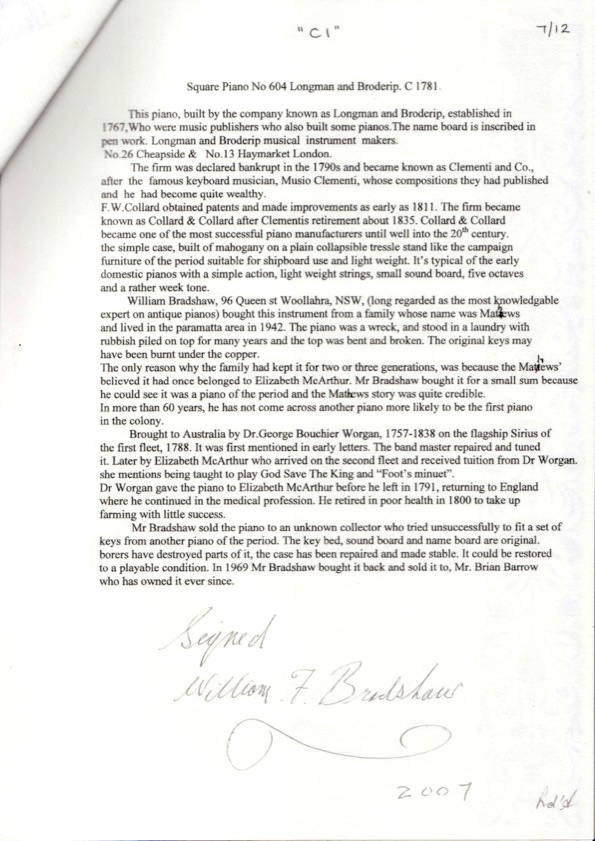
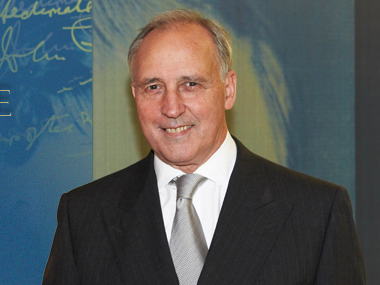
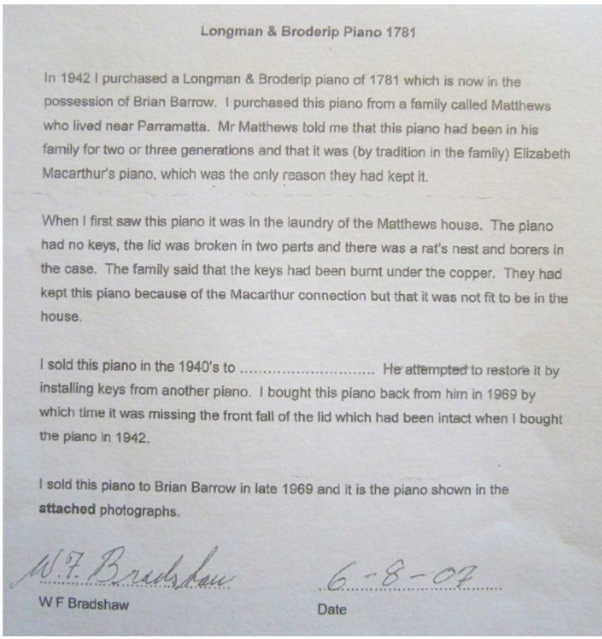
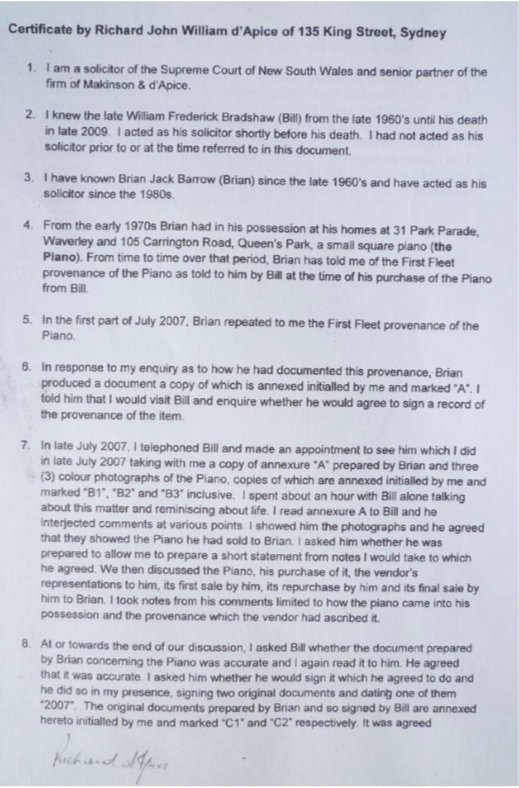

Joining the links from the Macarthurs to the Mathews family
The connections from the Macarthur family to the Allport family to the Adam family, then to the Mathews show a continuity of residence in the Parramatta area, which may well indicate the possibility of passing on the little square piano from family to family. We cannot put too much emphasis on the idea the piano was kept, firstly by Mrs Macarthur, thinking George Worgan might be back to find out how she went with it, and then by the Allport, Adam and Mathews families because it was “Mrs Macarthur’s piano”. It is, however, conjecture.
The Allports at Elizabeth Farm
John Macarthur died in 1834, and following his death his large property holdings were inherited by his oldest son, Edward Macarthur, who lived in England.
Edward appointed Henry Curzon Allport as his agent to manage the properties that had belonged to John Macarthur.
After Mrs Macarthur died (1850), her estate was wound up, and items of household furniture were sold.4 A lot of furniture was sold off, but not the little square piano – it was not advertised, so it is assumed it was not sold. After Mrs Macarthur died in 1850 there are three possible times when her furniture could have been sold: Immediately after Elizabeth’s death in 1850; 20 April 1854; and 1865.5
There is no evidence to show the first piano in the colony was sold at all.
Henry Curzon Allport was not only a property agent. He was also a watercolourist and art teacher. He died in 1854, not long after he and his large family moved into Elizabeth Farm. The agency of the Macarthur properties, for the time being, was taken over by his son, William Edward Allport, and the family stayed for a while at Elizabeth Farm. There were five daughters who would have wanted to play the piano – it was all the rage at the time, as well as a form of entertainment and a worthwhile way of passing the time. There were also three sons. The family was rather short of money after the death of Henry. They stayed on at Elizabeth Farm until the end of 1863 when Edward Macarthur transferred the work of his agent in Australia to Messrs Bowman and Chisholm (both members of the extended Macarthur family who lived in the Camden area), who both lived in the vicinity of Camden.
I propose that the little piano stayed at Elizabeth Farm and with the Allport family. It seems that having lost Henry Curzon Allport, the family was not well off. On 1 January 1864, the Allport family moved out of Elizabeth Farm to a property called “Denham”, which was in the Dundas area.6 Edward Macarthur decided to lease the estate, and the Macarthur family were given the opportunity to purchase items of furniture. The rest was disposed of by auction.7 I can find one advertisement for that auction – 21 September 1865 at page 7 of the 19 September edition of The Empire. Added to that, it is unclear which items of furniture had belonged to John Macarthur, and thus became the property of Edward Macarthur, so disposed of via auction, and which items had belonged to Elizabeth Macarthur and bequeathed in her will (her probate documents do not list items individually); and items of little or no value that were still at Elizabeth Farm, and possibly given to the Allports. The records are sparse at this time unless you are a male land-owner.
We have to move forward to get a hint of what happened with the Allports after they left Elizabeth Farm. The obituary of Catherine Davison Allport,8 one of Henry Curzon Allport’s daughters, indicates that the family moved a short way across the Parramatta River to Dundas for a while. Later records9 show Mrs Bertha Allport living in a house at “Western Road” (meaning Great Western Highway), Parramatta10. She died on 10 September 1885. Her funeral notices show she died in a house named “Dangan” in Rosehill Street, Parramatta.11 Whether she owned the house or not has not been established.
At some point, the Allport family inherited, but details are unclear. Mrs Allport was the daughter of an exceedingly wealthy man, John Betts (1776 – 1864). John Betts left an estate valued at £30,000 – millions of dollars in today’s money. At some point, we know the Allport daughters inherited. It was only after Mrs Bertha Allport nee Betts died in 1885, the daughters bought property around Parramatta and beyond, that is, between 1896 and 1900. It is by then, the little square piano would have been quite out of date, but perhaps it was kept partly as the Allports, up until then, could not afford better, and partly because it was Mrs Macarthur’s piano.
The obituary of Henry Curzon Allport’s daughter, Catherine Davison Allport,12 written in 1929 after she died, gives some of the history of the Allport family after they moved out of Elizabeth Farm:
Miss C. D. Allport Death on Sunday
After an illness extending over a fairly lengthy period the death occurred in the early hours of Sunday morning of Miss Catherine Davison Allport, of Rosehill-Street, Parramatta. Miss Allport, who was the last of a large family was born at Camberwell, England, 91 years ago. She was the daughter of the late Henry Curzon Allport and came with her parents to Australia as an infant. After residing for a time at Botany and Concord, Mr. and Mrs. Allport came to Elizabeth Farm, where Mr. Allport was agent for General Sir Edward Macarthur. After the death of Mr. Allport, the family removed to Dundas, and subsequently returned to make their home in Parramatta South. As the result of the death of relatives in England, the Misses Allport inherited a fortune. As might be supposed, Miss Allport’s home contained many articles of historical importance, A sideboard, which was the property of Lady Fitzroy, wife of an early Governor, is in an excellent state of preservation, despite the fact that it is nearly 82 years since its former owner was tragically killed in Parramatta Park. A mother-of-pearl set, which is considerably over 100 years old, originally belonged to Miss Allport’s grandmother, and there are quite an array of articles of somewhat similar antiquity. At one time, Miss Allport had possession of a giant Bible that was more than 500 years old, and a male relative made the trip from England to convey that and other family relics to the Old Country. The funeral took place on Monday afternoon when the remains were laid to rest in St. John’s Cemetery, Parramatta, Rev. F. Wilde, officiating at the graveside.
Take note of Catherine Davison Allport’s obituary, shown above. Catherine Davison Allport liked to collect items of historical importance. The Worgan square piano may have been the only piano the family had. It may not have been saleable. A bit like a 486 computer, or a Holden Kingswood, really, still useful after it’s a few years out of date, if there’s nothing else, but more than that – it was of historical importance.
John Adam, the father of Clara Constance Allport Mathews, nee Adam was a neighbour of Catherine Davison Allport.
The Allports and the Adams
There is a relationship between the Allport family and the Adam family. The 1928 Electoral Roll13 records Clara Constance Allport Adam, living at 2 Alma Street, Parramatta with her parents, John and Susan Adam, prior to her marriage to Harry William Mathews. Clara Constance Allport Adam was born in 1896. The name Allport was added to her middle names as a mark of respect to the family that I suggest, was very generous to the Adam family. Her father, John Adam, was a painter (house painter, not artist) who had arrived from Scotland and settled in Parramatta in 1882. At first they lived in William Street, Parramatta, then about 1892, moved to the house in Alma Street, Parramatta, a short distance from a house called “Sherbrooke” where a number of the Allport siblings, including Catherine Davison Allport, lived from about 1886. Could it be that John and Susan Adam had a special relationship with one or more of the Allports? The connections are firstly the middle name of Allport being given to their daughter, secondly, Catherine Davison Allport was a witness to John Adam’s will. Could it be that Catherine Davison Allport was kind to the Adam family, or perhaps it was two-way, with John Adam helping Catherine Davison Allport?
1907 was a horror year for the Allport siblings, many of whom were living at “Sherbrooke” in Rosehill Street, Parramatta. In March that year, William Allport died from burns received when the curtains caught alight. In August, three of the siblings succumbed to influenza – Clara (age 64) on 3 August, Frank (age 70) on 5 August, and Florence (age 62) on 9 August.14
Deceased Estates
The Allport siblings’ deceased estates, needless to say, were rather difficult to sort out. Clara Lucilla Allport who died 3 August 1907 had as part of her estate an “old piano [value] £12”, as well as a “Ronish” piano valued at £40. Pianos were obviously important in the Allport family. Note that Clara Constance Allport Mathews nee Adam was the owner of the piano bought by Bill Bradshaw. Could it be that she was named after Clara Lucilla Allport?
There is no saying whether the “old piano” was in fact the first piano in the colony of NSW. It might have been. It is no less likely than a Beck piano that might have been the the first piano in the colony being sold in 1838 to someone 30 miles out of Sydney that might have been Windsor, as proposed by Lancaster.
Catherine Davison Allport, who died 9 April 1929 left in her estate a “Ronish” piano, now valued at £25, but no “old piano”. The date of grant of probate was 17 Mar 1929. Could it be that after the death of the four siblings in one year, Catherine did a bit of tidying up. Could it be that she either sold or gave the old piano to the painter, John Adam who she knew, and who lived around the corner?
Susan, John Adam’s wife, also left an upright piano in her estate after she died in 1929. She bequeathed it to her other daughter, Ida, not to Clara. Nevertheless, it shows an interest in playing the piano, and the piano being an important part of the household. In any event, Clara Constance Allport Mathews had a piano to sell to Bill Bradshaw. By the time Bill visited the Mathews family, the house in Alma Street had been sold and the Mathews family had moved to Briens Road Northmead, near Parramatta. Note from Bill Bradshaw’s written statement, that the family live NEAR Parramatta, not IN Parramatta. To go back to the written statement from Bill Bradshaw,15 it says,
In 1942 I purchased a Longman & Broderip piano which is now in the possession of Brian Barrow. I purchased this piano from a family called Matthews who lived near Parramatta. Mr Matthews told me that this piano had been in his family for two or three generations and that it was (by tradition in the family) Elizabeth Macarthur’s piano which was the only reason they had kept it.
We have a direct link from George Worgan, Elizabeth Macarthur, the Allport family, John and Susan Adam, to Mr Mathews and Mrs Mathews nee Adam, to Bill Bradshaw and Brian Barrow.
Bill Bradshaw’s will
A claim is made in footnote 60 of Lancaster’s book.16 It seems petty to pick on a footnote. The suggestion was given that Stewart Symonds was very much in favour with Bill Bradshaw because he was “the executor” of Bill Bradshaw’s will. Stewart Symonds was ONE executor of Bill Bradshaw’s will. The other was Peter Larcombe of Mona Vale. As for Stewart being a beneficiary, he was one of 30 beneficiaries. Bill had a lot of friends. The Powerhouse Museum was by far the biggest beneficiary, in terms of bequest of antiques. It seems that both Brian Barrow and Stewart Symonds saw themselves as Bill’s friend. To explain Bill Bradshaw’s motives in purportedly telling two friends a similar story about the provenance of two different pianos, I would refer to Paul Keating’s words in Bill’s obituary:
He was a ferocious salesman. I used to say, ‘You’re like a black widow spider’. He’d sidle out of that narrow door and come upon them. If they were old customers he would know the approach, but if they were new customers he’d go through the patter, slowly reeling them in — it was something to see. 17
Also, I add the words of the Hon Paul Keating, “Bill Bradshaw might gild the lily a little, but not on something like this. A musical instrument was important to him. In the end, it comes down to Bill Bradshaw’s professional pride – he would not misrepresent something. If Bill Bradshaw had already sold a piano with such provenance, he would NEVER sell another with the same provenance”.
My conclusion is that Bill Bradshaw would never have put his claims in writing if he knew them to be untrue. I have traced the background to the claim about the Longman & Broderip piano, and have found that what Bill told Brian Barrow, and later backed up with a signed statement, is most likely to be true. I have serious misgivings about the claim that the Beck piano is the “First Fleet Piano” for the following reasons:
- The legs are too unusual – there is no satisfactory explanation as to why they were an essential requirement for the piano to be on the First Fleet;
- The woodwork, and in particular, the delicate Tunbridge-ware marquetry is completely undamaged, even though this piano came through on a sailing ship. the establishment of the colony, and it seems, the floods at Windsor;
- The story about the piano being in a farmhouse in Windsor, when Windsor had so many floods “doesn’t hold water” – again, consider the pristine condition of this piano;
- There is no record of Bill Bradshaw buying a Beck piano from a house in Windsor. In fact Bill Bradshaw only ever bought one Beck piano – from a house in North Bondi;
- There is no provenance provided about the history of the Beck piano bought in 1973 from a house in North Bondi;
- There is no record of a piano of the description of the Beck piano being restored;
- There is no written provenance from Bill Bradshaw, just word of mouth; and
- Bill Bradshaw’s impeccable reputation.
If either of the two pianos is indeed the “First Fleet Piano”, the Longman & Broderip piano belonging to Brian Barrow has by far the better claim. The reasons for my opinion are:
- The connection between Longman & Broderip and Dr John Worgan, George Worgan’s father;
- The condition of the piano – it has suffered more than most pianos that still exist;
- The opinion of the Hon Paul Keating, that Bill Bradshaw would never, out of his professional pride, sell two items with the same provenance;
- The written provenance from Bill Bradshaw;
- The continuum of family connections from the Macarthurs through to the Mathews family who sold the piano to Bill Bradshaw; and
- Bill Bradshaw’s impeccable reputation.
Conclusion
I have examined the evidence, or lack of thereof, for the two pianos as candidate for the first piano in the colony. It must be borne in mind that a piano purchased from the Broadwood company in London by a Mr Worgan has not been found, and could well be the elusive George Worgan piano given to Mrs Macarthur back in 1791. Because we do not know the make and model of piano that George Worgan brought with him to New South Wales, we cannot be certain that it is either of the contenders – a Beck piano at the Western Australian Academy of Performing Arts, or a Longman & Broderip piano belonging to Brian Barrow. Nevertheless, the Longman & Broderip piano can be thought of as the most likely First Fleet piano that has surfaced so far. There is a good connection from Longman & Broderip in London to George Worgan, to Mrs Macarthur, to the Allport family, to the Mathews family, to Bill Bradshaw and finally to Brian Barrow.
Here is a brief timeline:
Suggested Worgan Piano Timeline
| 1759 to 1790s | Longman & Broderip published some of Dr John Worgan’s compositions. |
| 1787-1788 | George Worgan travelled on the Sirius to Botany Bay. He took with him his piano (of unknown make). |
| 1791 | Just before he left the colony for England, never to return, George Worgan gave his piano to Elizabeth Macarthur. |
| 1793 | Elizabeth Macarthur took the piano with her to Elizabeth Farm. |
| 1834 | John Macarthur died. His son Edward appointed Henry Curzon Allport as property agent. |
| 1850 | Elizabeth Macarthur died. As no square piano was advertised for sale, it was not sold but possibly left behind (as by then it was worthless). |
| 1854 | Soon after the Allport family moved into Elizabeth Farm, Henry Curzon Allport died. |
| 1854 to 1863 | Henry’s son William, took over the agency for Edward Macarthur. This is a continuation of the relationship between the Macarthurs and the Allports. |
| 1854 to 1863 | Possibly the Allport family became aware of the historical importance of the piano. |
| 1863 | Edward Macarthur terminated William Allport’s agency. |
| November 1865 | Following an inheritance from her father, Bertha Allport, Henry Curzon Allport’s widow, purchased Kishnaghur, a large house in the Dundas Valley. It is suggested that the whole family moved there and the piano went with them. We know Catherine Davison Allport, one of the daughters, had an interest in collecting historic memorabilia. |
| 10 September 1885 | Bertha Allport died. |
| About 1886 | Catherine Davison Allport bought “Sherbrooke” in Rosehill St, Parramatta. |
| 1896 | Clara Constance Allport Adam, daughter of house painter John Adam was born. The family lived in Alma St Parramatta, not far from “Sherbrooke”. The Allport name inserted into Clara's shows respect for the Allport family - either Clara Lucilla Allport or Catherine Davison Allport. |
| 1923 | Catherine Davison Allport witnessed John Adam’s will. This is another example of the close bond between the Allports and the Adam family. |
| 1928 | Clara Constance Allport Adam married Harry Mathews. They moved to a house in Briens Road, Northmead, which is near Parramatta. It is suggested that the historic piano went with them. |
| 1942 | Bill Bradshaw bought a wreck of a square piano from the Mathews family, who lived near Parramatta. The family had only kept it because it was Elizabeth Macarthur’s piano. |
| 1969 | Brian Barrow bought the piano from Bill Bradshaw. Brian has had the piano ever since. |
This website will be updated when new material comes to light.
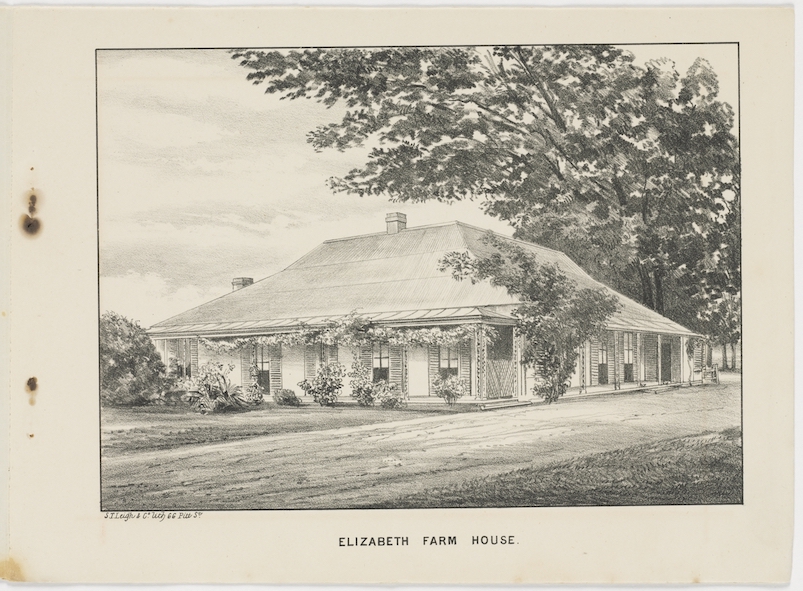

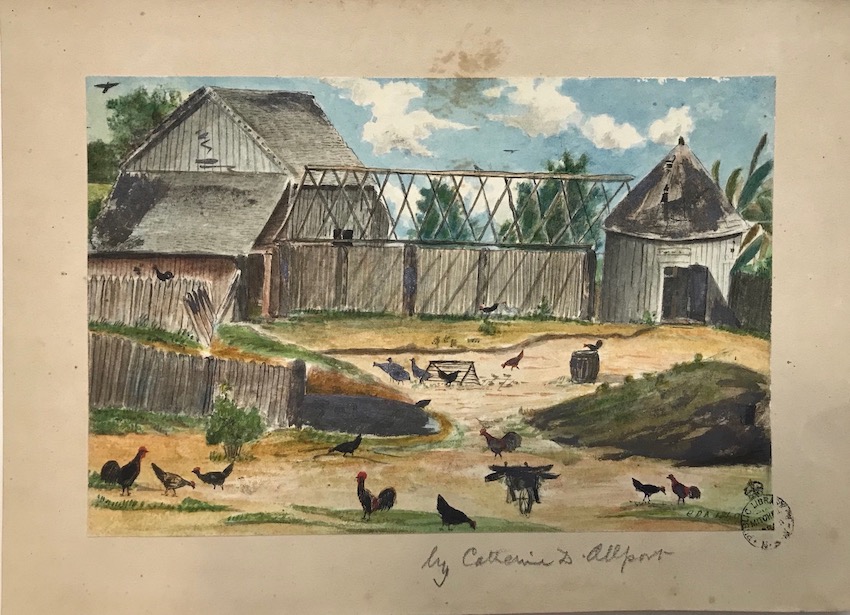
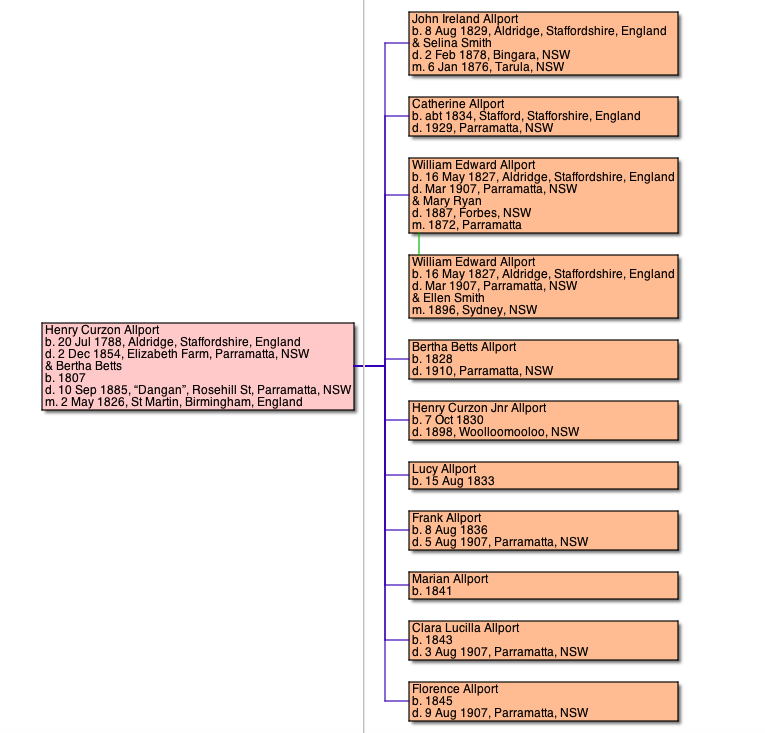
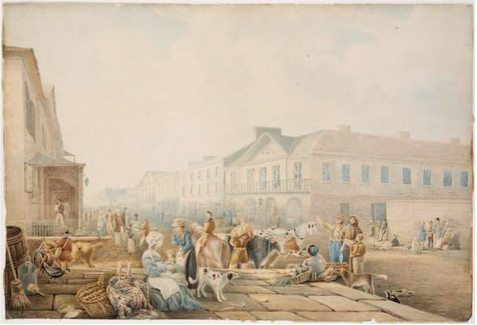
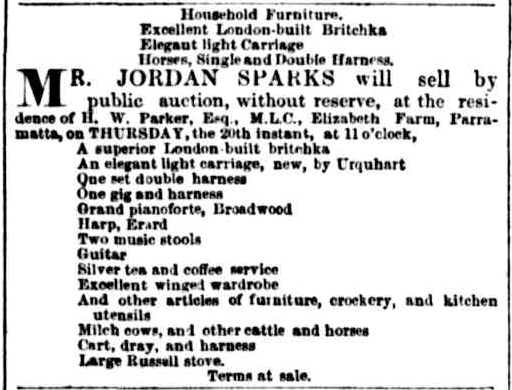
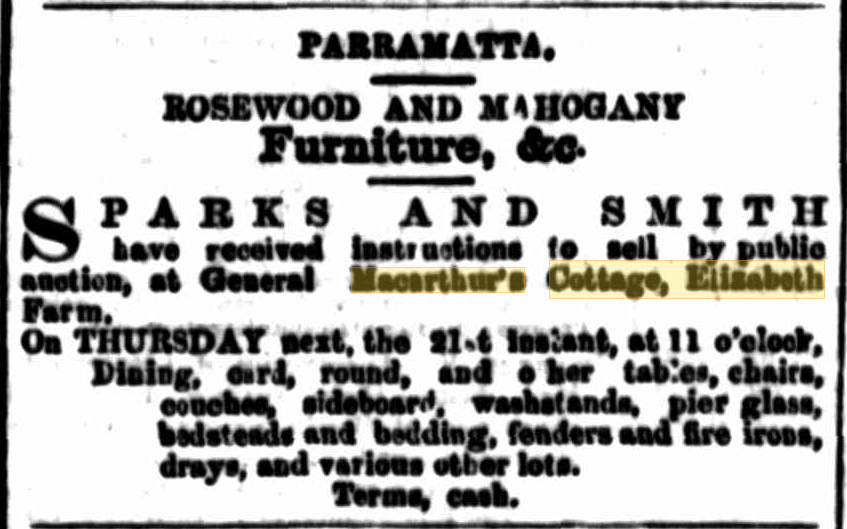



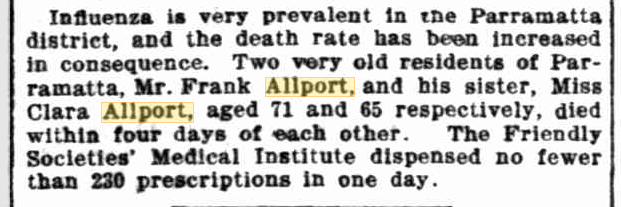
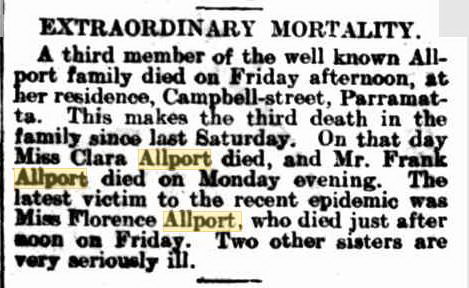
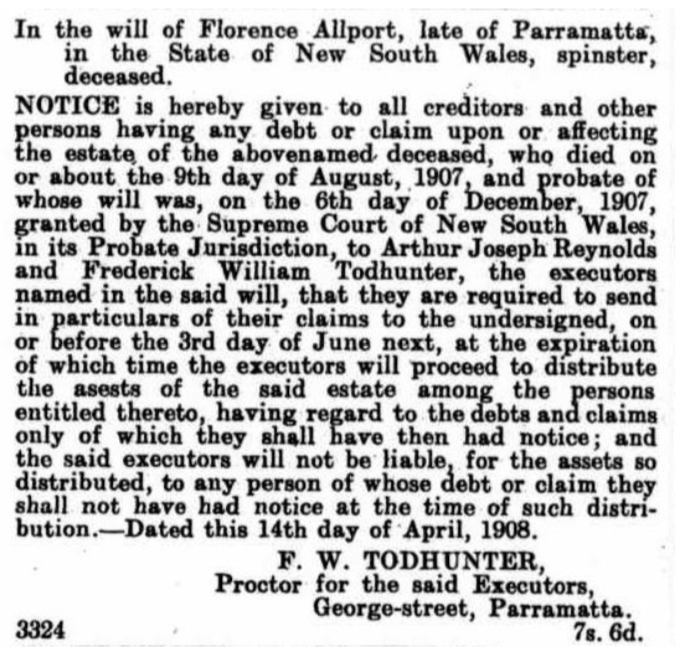
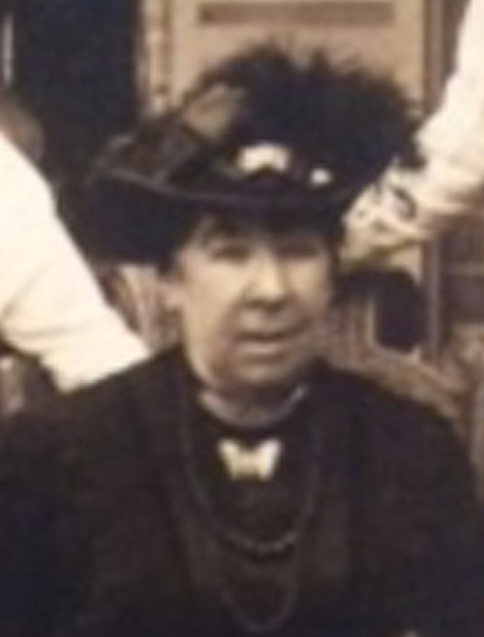
- See the document below labelled “C1” signed by Bill Bradshaw and dated 2007
- See statement to the left, signed by Bill Bradshaw and dated 6/8/2007.
- Telephone conversation with the Hon Paul Keating, 14 February 2019
- Sydney Morning Herald 17 April 1854, page 7
- “The Empire” 19 September 1865, page 7
- The Diary of Miss Allport 1863-4, Mitchell Library, Sydney, call no. B 507.
- 1865 auction advertised in The Empire, see picture to the right below.
- See transcription of the obituary in italics below.
- 1885 – Fullers Central Cumberland Directory, viewed at the Royal Australian Historical Society.
- Sands Directory of 1884
- See funeral notice to the right above.
- Cumberland Argus and Fruitgrowers Advocate (Parramatta, NSW : 1888 – 1950), Thursday 21 March 1929, page 16 – this is a very poor reproduction, thus the transcription
- This electoral roll is available for viewing in the State Library of NSW
- See newspaper reports to the right.
- See full text of the signed statement at the bottom of this page
- Lancaster, op. cit., volume 1, page 14, footnote 60
- Eulogy on the Death of Bill Bradshaw, by the Hon P J Keating, 25 November 2009, Woollahra


